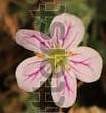Australian stork's bill
(Erodium cygnorum)

Description
Erodium cygnorum is a species of herb native to Australia. It is commonly known as blue heronsbill in Western Australia, and blue storksbill in South Australia. In the United States, where the species is cultivated as a garden plant, it is commonly known as Australian stork's bill and Australian filaree. In the British Isles, it is commonly known as western stork's-bill. It grows as an annual or perennial herb up to 60 centimetres high, with blue, purple or pink flowers. This species was published in 1845, based on a specimen collected from the vicinity of Perth, Western Australia by Ludwig Preiss in 1839. In 1958, Roger Charles Carolin published a subspecies, Erodium cygnorum subsp. glandulosum, but this has since been promoted to species rank as E. carolinianum. No infraspecific taxa of E. cygnorum are currently recognised. It is native to Australia, occurring in Western Australia, South Australia and the Northern Territory. The National Herbarium of New South Wales lists E. cygnorum as also occurring in New South Wales, but they further identify their specimens as E. cygnorum subsp. glandulosum; that is, E. carolinianum. It favours red sand or clay loam, occurring in low-lying flats, along creeklines and on the margins of salt lakes. Erodium is a genus of flowering plants in the botanical family Geraniaceae. The genus includes about 60 species, native to North Africa, Indomalaya, the Middle East, and Australia. They are perennials, annuals, or subshrubs, with five-petalled flowers in shades of white, pink, and purple, that strongly resemble the better-known Geranium (cranesbill). Cultivated plants are known as filarees or heron's bill in North America, whereas in the British Isles they are usually called storksbills. Carl Linnaeus grouped in the same genus (Geranium), the three similar genera Erodium, Geranium, and Pelargonium. The distinction between them was made by Charles Louis L'Héritier de Brutelle based on the number of stamens or anthers: five for Erodium, seven for Pelargonium, and ten for Geranium. However, the three genera have the same characteristics in regard to their fruit, which resemble long bird beaks. That characteristic is the basis for the names: Geranium evokes the crane (Greek geranos), Pelargonium the stork (pelargos), and Erodium the heron (erodios).
Taxonomic tree:







